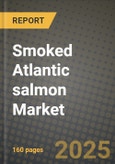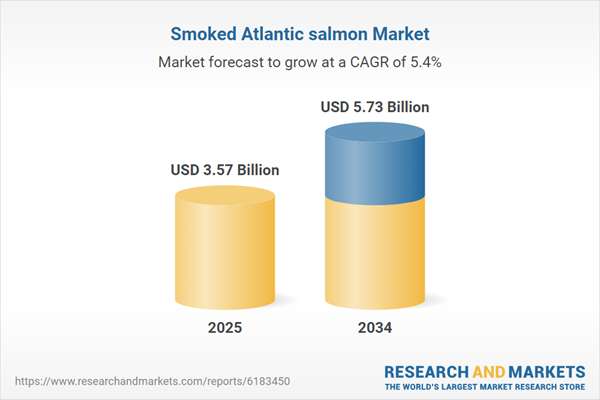Smoked Atlantic salmon Market
The Smoked Atlantic Salmon market centers on cold- and hot-smoked products derived primarily from farmed Atlantic salmon, presented as thin-sliced shingle packs, premium loins, pre-portioned fillets, pâtés, and snack formats for retail, foodservice, airline catering, and e-commerce. Core end-uses include breakfast/brunch, sushi and canapés, pizza and salad toppings, charcuterie boards, and premium ready meals. Current trends emphasize clean labels and natural smokes, lower sodium brines, distinctive wood signatures (beech, oak, apple), chef collaborations, and provenance stories tied to Nordic, Scottish, Canadian, and Tasmanian origins. Growth is propelled by at-home entertaining, protein-forward snacking, and modernization of aquaculture supply with welfare and environmental certifications. The competitive landscape blends global salmon specialists, diversified seafood majors, artisanal smokehouses, and retailer private labels; differentiation hinges on cure discipline, smoke density and phenolic profile, slice integrity, low purge, and consistent color and marbling. Execution priorities include robust Listeria control in RTE environments, cold-chain resilience, brine uptake and kiln airflow mapping, and packaging that protects color while showcasing premium optics. Key challenges span raw material price volatility, climate and disease risks in farming, evolving sodium and smoke-flavor regulations, allergen governance, and balancing indulgent smoke with broader wellness expectations. Winners combine culinary craft with industrial discipline - validated post-lethality protection, SPC on moisture/weight loss, and transparent ESG dashboards - while tailoring cut formats and flavors to channel-specific needs.Smoked Atlantic salmon Market Key Insights
- Species, origin, and trim strategy define the price ladder and risk posture. Premium tiers lean on superior fat-cover fish from cold-water origins with strong welfare credentials, supporting thin-slice deli packs and sushi-grade loins. Secondary tiers utilize trimmings for pâtés and flakes to optimize yields. Multi-origin sourcing hedges climatic and biological risks, stabilizing promotions and retail planograms across seasons and events.
- Process control from fillet grading to smoke curve drives consistency at scale. Brine concentration, dwell time, and fish geometry govern salt uptake and texture; kiln airflow, wood moisture, and temperature ramp set phenolics, hue, and surface tack. Rapid chilling after smoke minimizes purge; calibrated slicers preserve translucency and marbling. Inline weight-loss curves and core-temp verification reduce rework and protect yield.
- Food safety and post-lethality hurdles are non-negotiable in RTE seafood. Zoning and environmental monitoring target Listeria; validated lethality or alternative hurdles, condensation control, and hygienic slicing lines reduce contamination risk. Clear corrective-action playbooks, farm-to-pack traceability, and recall readiness sustain retailer and regulator confidence while maintaining desired shelf life without excessive sodium.
- Packaging engineering underpins shelf life, optics, and e-commerce resilience. High-barrier vacuum or MAP with controlled oxygen protects color, aroma, and texture. Interleafs and easy-open features preserve slice release for deli aesthetics. For snacks and flakes, oxygen scavengers and light barriers limit rancidity. E-commerce formats require tamper evidence and thermal modeling to manage last-mile variability.
- Sustainability credentials are becoming listing gates, not differentiators. Retailers score welfare, feed, and environmental disclosures alongside packaging recyclability and waste reduction. Carbon-per-pack, water use, and by-product upcycling (trims into pâtés/crumbles) influence shelf placement. Suppliers aligning procurement, processing energy, and packaging to retailer scorecards win durable space.
- Flavors and finishing deliver premiumization without line complexity. Maple, peppered, herb-crusted, and yakiniku glazes layer on top of standard cure/smoke SOPs, enabling seasonal rotations and collabs. Texture-first innovations - hot-smoked flakes for salads, premium loins for sushi sets - expand occasions. QR-linked pairings and plating guides raise basket size and repeat rates.
- Private label lifts the quality floor; brands must build stories and experiences. Retailer brands mirror benchmark profiles at value, tightening specs on slice integrity and color. Brands differentiate via provenance, kiln heritage, limited-wood releases, and chef endorsements. Transparent brine/sodium disclosures and simple ingredients satisfy clean-label screens without eroding indulgence cues.
- Foodservice needs speed, uniformity, and cross-menu utility. Pre-portioned shingles and hot-smoked flakes reduce prep and shrink during peaks. Consistent thickness, low oil-out, and reliable thaw/hold behavior protect plate economics. Distributor packs emphasize resealability and clear day-dot guidance to minimize waste in brunch and pizza channels.
- Supply resilience is a board-level KPI. Weather and biology drive fat content, pigmentation, and fillet geometry variability; forward contracts, dual-hemisphere sourcing, and frozen raw inventory strategies stabilize specs. Flexible brine/smoke recipes maintain sensory targets across lots while protecting yields and margins.
- Regulatory and nutrition trends shape reformulation roadmaps. Sodium reduction and natural smoke labeling tighten guardrails; additive scrutiny favors condensate smokes with precise dosing. Allergen and cross-contact controls (including emerging sesame rules) require facility design and label architecture updates. Balanced messaging - omega-rich protein with crafted smoke - outperforms austere health claims.
Smoked Atlantic salmon Market Reginal Analysis
North America
Volume is anchored in sliced cold-smoked packs for retail, complemented by brunch, pizza, and premium salad channels. Private label competes on clean-label parity and slice release; national brands lean on provenance and wood narratives. Logistics breadth necessitates robust frozen-raw strategies and barrier packaging for long-haul distribution. ESG dashboards and welfare disclosures influence chain RFPs.Europe
Deep heritage in Nordic and UK smoke traditions with strict additive and smoke-condensate rules. Chilled retail and deli counters dominate; private label is strong and quality expectations are exacting. Retailers scrutinize sodium, recyclable glass/boards, and welfare certifications. Foodservice values consistent shingle dimensions, low purge, and stable color for buffets and banqueting.Asia-Pacific
Demand led by Japan and Australia for cold-smoked salmon, with broader regional uptake through modern trade and e-commerce. Localized flavors (yuzu-pepper, teriyaki, gochujang) accelerate trial. Mixed-format portfolios - slices, loins, flakes - serve sushi, salads, and snacking. Heat/humidity logistics prioritize high-barrier packs, rapid chilling, and tight distributor SOPs.Middle East & Africa
Concentrated in premium retail, hospitality, and airline catering across major metros. Long supply lines and hot climates require stringent cold-chain and high-barrier packaging. Halal alignment, bilingual labels, and sodium transparency are baseline. Pre-portioned shingles and pâté cups reduce back-of-house prep and ensure buffet consistency.South & Central America
Emerging interest via modern retail, gourmet pizza, and brunch channels. Currency and import variability favor flexible specs, regional co-packing where feasible, and SKU simplification. Flavor innovation draws on local herbs and citrus. Packaging must withstand warm chains; MAP/vacuum with oxygen scavengers and tamper evidence builds consumer trust.Smoked Atlantic salmon Market Segmentation
By Type
- Hot Smoking
- Cold Smoking
By Application
- Food Service Sector
- Retail Sector
Key Market players
Mowi ASA, Leroy Seafood Group, SalMar ASA, Marine Harvest, Bakkafrost, Grieg Seafood, Cooke Aquaculture, SeaDelight, Labeyrie Fine Foods, Acme Smoked Fish Corporation, John Ross Jr. (Aberdeen), Scottish Sea Farms, Huon Aquaculture, Tassal Group, DelpeyratSmoked Atlantic salmon Market Analytics
The report employs rigorous tools, including Porter’s Five Forces, value chain mapping, and scenario-based modelling, to assess supply-demand dynamics. Cross-sector influences from parent, derived, and substitute markets are evaluated to identify risks and opportunities. Trade and pricing analytics provide an up-to-date view of international flows, including leading exporters, importers, and regional price trends.Macroeconomic indicators, policy frameworks such as carbon pricing and energy security strategies, and evolving consumer behaviour are considered in forecasting scenarios. Recent deal flows, partnerships, and technology innovations are incorporated to assess their impact on future market performance.
Smoked Atlantic salmon Market Competitive Intelligence
The competitive landscape is mapped through proprietary frameworks, profiling leading companies with details on business models, product portfolios, financial performance, and strategic initiatives. Key developments such as mergers & acquisitions, technology collaborations, investment inflows, and regional expansions are analyzed for their competitive impact. The report also identifies emerging players and innovative startups contributing to market disruption.Regional insights highlight the most promising investment destinations, regulatory landscapes, and evolving partnerships across energy and industrial corridors.
Countries Covered
- North America - Smoked Atlantic salmon market data and outlook to 2034
- United States
- Canada
- Mexico
- Europe - Smoked Atlantic salmon market data and outlook to 2034
- Germany
- United Kingdom
- France
- Italy
- Spain
- BeNeLux
- Russia
- Sweden
- Asia-Pacific - Smoked Atlantic salmon market data and outlook to 2034
- China
- Japan
- India
- South Korea
- Australia
- Indonesia
- Malaysia
- Vietnam
- Middle East and Africa - Smoked Atlantic salmon market data and outlook to 2034
- Saudi Arabia
- South Africa
- Iran
- UAE
- Egypt
- South and Central America - Smoked Atlantic salmon market data and outlook to 2034
- Brazil
- Argentina
- Chile
- Peru
Research Methodology
This study combines primary inputs from industry experts across the Smoked Atlantic salmon value chain with secondary data from associations, government publications, trade databases, and company disclosures. Proprietary modeling techniques, including data triangulation, statistical correlation, and scenario planning, are applied to deliver reliable market sizing and forecasting.Key Questions Addressed
- What is the current and forecast market size of the Smoked Atlantic salmon industry at global, regional, and country levels?
- Which types, applications, and technologies present the highest growth potential?
- How are supply chains adapting to geopolitical and economic shocks?
- What role do policy frameworks, trade flows, and sustainability targets play in shaping demand?
- Who are the leading players, and how are their strategies evolving in the face of global uncertainty?
- Which regional “hotspots” and customer segments will outpace the market, and what go-to-market and partnership models best support entry and expansion?
- Where are the most investable opportunities - across technology roadmaps, sustainability-linked innovation, and M&A - and what is the best segment to invest over the next 3-5 years?
Your Key Takeaways from the Smoked Atlantic salmon Market Report
- Global Smoked Atlantic salmon market size and growth projections (CAGR), 2024-2034
- Impact of Russia-Ukraine, Israel-Palestine, and Hamas conflicts on Smoked Atlantic salmon trade, costs, and supply chains
- Smoked Atlantic salmon market size, share, and outlook across 5 regions and 27 countries, 2023-2034
- Smoked Atlantic salmon market size, CAGR, and market share of key products, applications, and end-user verticals, 2023-2034
- Short- and long-term Smoked Atlantic salmon market trends, drivers, restraints, and opportunities
- Porter’s Five Forces analysis, technological developments, and Smoked Atlantic salmon supply chain analysis
- Smoked Atlantic salmon trade analysis, Smoked Atlantic salmon market price analysis, and Smoked Atlantic salmon supply/demand dynamics
- Profiles of 5 leading companies - overview, key strategies, financials, and products
- Latest Smoked Atlantic salmon market news and developments
Additional Support
With the purchase of this report, you will receive:- An updated PDF report and an MS Excel data workbook containing all market tables and figures for easy analysis.
- 7-day post-sale analyst support for clarifications and in-scope supplementary data, ensuring the deliverable aligns precisely with your requirements.
- Complimentary report update to incorporate the latest available data and the impact of recent market developments.
This product will be delivered within 1-3 business days.
Table of Contents
Companies Mentioned
- Mowi ASA
- Leroy Seafood Group
- SalMar ASA
- Marine Harvest
- Bakkafrost
- Grieg Seafood
- Cooke Aquaculture
- SeaDelight
- Labeyrie Fine Foods
- Acme Smoked Fish Corporation
- John Ross Jr. (Aberdeen)
- Scottish Sea Farms
- Huon Aquaculture
- Tassal Group
- Delpeyrat
Table Information
| Report Attribute | Details |
|---|---|
| No. of Pages | 160 |
| Published | November 2025 |
| Forecast Period | 2025 - 2034 |
| Estimated Market Value ( USD | $ 3.57 Billion |
| Forecasted Market Value ( USD | $ 5.73 Billion |
| Compound Annual Growth Rate | 5.4% |
| Regions Covered | Global |
| No. of Companies Mentioned | 15 |









